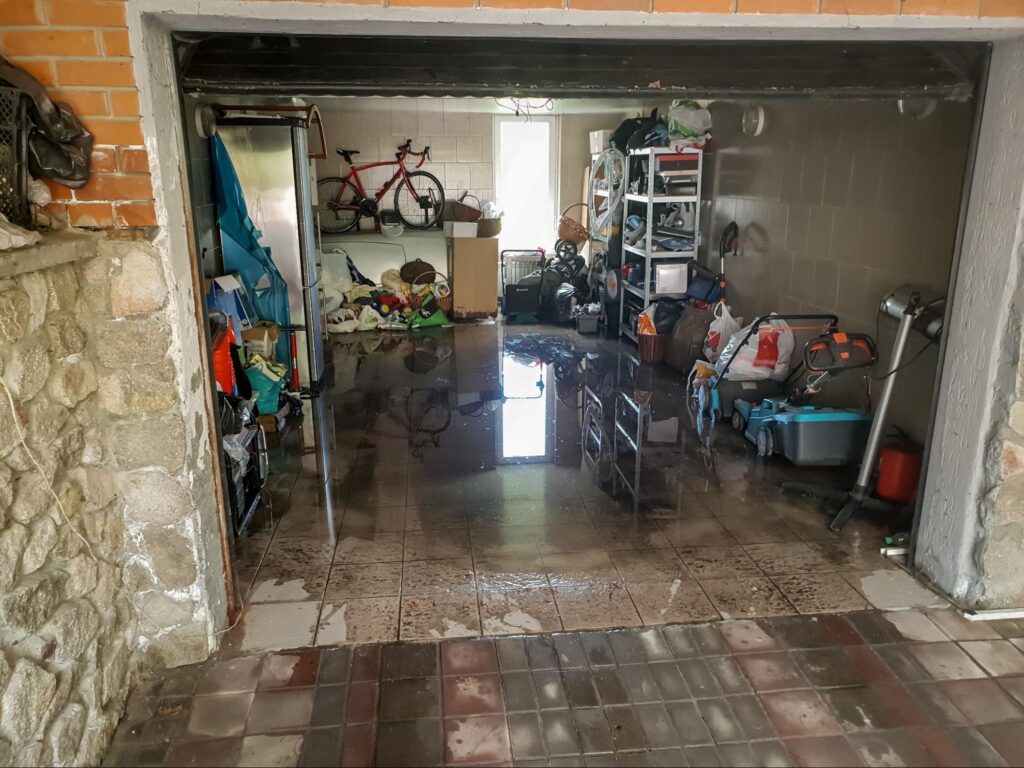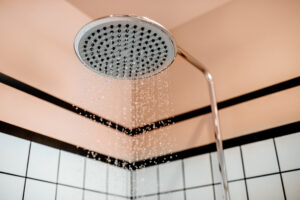A flooded basement is a homeowner’s nightmare, leading to costly water damage, the risk of mold, and the loss of valuable space. While proper grading and waterproofing are important, the single most effective defense against groundwater intrusion is a reliable sump pump. This system is your property’s primary and active solution for collecting and removing water before it can cause catastrophic harm.
This comprehensive guide covers everything you need to know—from choosing the right type of pump and ensuring a smart installation to performing proactive maintenance. By understanding how to leverage this essential tool, you can protect your investment and maintain a safe, dry basement for years to come.
How a Sump Pump Protects Your Home
At its core, a sump pump is your home’s dedicated defense system against groundwater intrusion and basement flooding. It’s an automated pump installed in the lowest part of your basement or crawlspace, designed to act before water levels can rise and cause damage. By understanding its basic principle and key components, you can appreciate the vital role it plays in keeping your property safe and dry.
The Basic Principle: Collecting and Pumping Water
The concept behind a sump pump system is simple yet highly effective: intercept and redirect water. As groundwater levels rise—especially during heavy rain or snowmelt—the water is guided by drainage channels or natural seepage into a specially constructed basin, known as a sump pit. When the water in the pit reaches a predetermined level, a float switch activates the pump. The pump then forces the water out of the pit and through a discharge pipe, safely away from your home’s foundation.
The Key Components Working Together
A sump pump is not just a single device but a system of four critical components that must work in harmony:
- The Sump Pit (or Basin): This is the perforated liner installed in the floor that acts as the collection point. It’s strategically placed to gather water from weeping tiles or natural seepage before it can spread across your basement floor.
- The Pump: This is the heart of the system. It can be either a submersible model (sitting inside the pit) or a pedestal model (with the motor above the pit). Its job is to move the collected water out.
- The Check Valve: This is a crucial one-way valve installed on the discharge pipe. After the pump turns off, the check valve closes to prevent the water that’s still in the pipe from flowing back down into the pit, which would cause the pump to turn on again unnecessarily.
- The Discharge Line: This is the pipe that carries the water from the pump to a safe location outside, far enough away from your foundation that it won’t seep back into the ground and re-enter your basement.
Choosing the Right Sump Pump System for Your Needs

Selecting the right sump pump is critical for effective basement water management. Each type has distinct features and costs tailored to different property needs.
Primary Sump Pumps: The Main Defense
Primary pumps are the workhorses of water removal. Your main choice is between a submersible and a pedestal model.
Submersible Pumps
Installed fully within the sump pit, these pumps operate quietly and are highly efficient at handling large volumes of water, making them ideal for homes with significant water issues.
- Approximate Cost: The pump itself typically ranges from $200 to $500, reflecting their more robust design and performance.
Pedestal Pumps
With the motor positioned on a shaft above the pit, pedestal pumps are easier to access for maintenance and are generally more budget-friendly. They can be noisier than submersible models, making them a consideration for unfinished basements or utility rooms.
- Approximate Cost: A basic pedestal pump is more economical, usually costing between $150 and $300 for the unit.
Backup Systems: Your Fail-Safe
A primary pump is only effective when it has power. Backup systems are your essential insurance policy during storms or power outages.
Battery Backup Sump Pumps
These pumps activate automatically when power fails, ensuring continuous protection. Installed adjacent to the primary pump, they are the most common and reliable backup solution for most homes.
- Approximate Cost: Adding a battery backup system typically costs $200 to $600 for the equipment, not including the main pump.
Water-Powered Sump Pumps
Operating on your home’s municipal water pressure, these pumps provide an eco-friendly backup option without the need for electricity or batteries. They are effective in areas with reliable and strong water pressure but may be subject to local regulations.
Combination Sump Pumps
For a streamlined solution, combination systems offer both a primary and a battery backup pump in one pre-assembled unit, simplifying installation and ensuring continuous protection.
Smart Installation & Design for Maximum Effectiveness
Choosing the right sump pump is only half the battle; its long-term reliability and effectiveness depend entirely on a smart, professional installation. A poorly designed system—even with the best pump—can lead to frequent cycling, frozen pipes, and even water flowing back toward your foundation.
Critical Design Factors for a Reliable System
Before a single tool is used, a successful installation begins with a strategic plan. These design factors are non-negotiable for a system that will stand the test of time.
Sump Pit Placement and Sizing
The sump pit must be installed at the lowest point of your basement or crawlspace, where water will naturally collect first. The size of the pit is also crucial. A pit that is too small will cause the pump to “short cycle” (turn on and off too frequently), leading to premature motor burnout. A pit that is too large may allow too much water to accumulate before the pump activates. A professional will recommend the optimal pit diameter and depth based on your soil conditions and the capacity of your pump.
Discharge Line Routing & Freeze Mitigation
The discharge line must route water far away from your foundation to a location where it can drain away harmlessly without pooling. A consistent, gentle downward slope is essential to prevent water from sitting in the pipe. In colder climates like Evansville, Indiana, this is especially critical to prevent freezing. To mitigate the risk of a frozen and blocked discharge line in winter, consider:
- Insulating the exterior portion of the pipe.
- Installing a specialized, freeze-resistant discharge outlet.
The Installation Process Overview
While some experienced homeowners may tackle a sump pump installation, hiring a licensed plumber is the best way to guarantee that all components are correctly installed and compliant with local codes. The professional process generally involves:
- Site Evaluation: A plumber will first confirm the lowest point of your basement and map out the most effective and least obtrusive route for the discharge line.
- Pit Preparation: This is the most labor-intensive step, involving breaking through the concrete floor to excavate the area for the sump pit. The pit liner is then set in place and secured.
- Pump and Basin Placement: The pump is placed inside the pit, ensuring the float switch has clear, unobstructed movement to activate properly.
- Assembly and Connection: The check valve is installed, and the PVC discharge pipe is connected and routed through the foundation wall to the designated exit point outside.
- Final Testing: Once everything is sealed and connected, the plumber will test the system by pouring several buckets of water into the pit to confirm that the float switch activates, the pump runs smoothly, and water is discharged correctly.
Approximate Professional Installation Cost
The cost for a professional installation can range from $500 to $1,500. This price varies significantly based on the complexity of the job, such as whether a new pit needs to be excavated, the length and difficulty of the discharge line setup, and local labor rates. Always consult a local professional for a detailed and accurate estimate tailored to your property.
Permits and Code Compliance
Depending on your municipality, installing a new sump pump system, especially one that requires breaking the concrete slab and routing a new discharge line, may require a permit. A professional plumber will be familiar with local building codes—such as regulations on where water can be discharged—ensuring your installation is both safe and compliant, and preventing potential fines or issues down the road.
A Proactive Maintenance & Troubleshooting Plan
Your sump pump is one of the hardest-working appliances you’ll never see, but it can’t be ignored. Like any mechanical system, it requires regular maintenance to ensure it will be ready to perform during a critical moment. A proactive maintenance and troubleshooting plan is the best way to extend the life of your pump, prevent unexpected failures, and ensure your basement remains protected season after season.
Your Seasonal Maintenance Checklist
Performing these simple checks a few times a year—especially in the spring and fall before the wettest seasons—can prevent the vast majority of sump pump failures.
- Test the Pump: The easiest and most important check is to ensure the pump actually runs. Slowly pour a bucket of water into the sump pit. The float switch should rise and activate the pump. Watch to make sure the water is pumped out and the pump shuts off automatically afterward.
- Clean the Pit: Unplug the pump and remove any dirt, gravel, silt, or other debris from the bottom of the pit. This prevents the pump’s intake from getting clogged, which can damage the motor.
- Inspect the Check Valve: Ensure the check valve is installed correctly (the arrow should point away from the pump) and that it’s not leaking. When the pump shuts off, you should not see water flowing back into the pit.
- Clear the Discharge Line: Take a walk outside to the end of your discharge line. Make sure it is free from obstructions like dirt, leaves, animal nests, or ice, which could prevent water from exiting.
- Secure the Power Supply: Check that the pump is securely plugged in. For added protection, consider plugging it into a Ground Fault Circuit Interrupter (GFCI) outlet.
- Approximate Professional Maintenance Cost: For homeowners who prefer professional servicing, a routine maintenance visit typically costs between $100 and $300 per year. This service usually includes a thorough inspection, cleaning of the pit and components, and testing of the primary and backup systems, providing valuable peace of mind.
Troubleshooting Common Sump Pump Issues
Even with good maintenance, you may encounter issues. Here are some quick fixes for common problems:
Problem: The pump won’t turn on.
- Quick Fixes: Check if it’s plugged in and if the circuit breaker has tripped. The float switch might also be stuck or obstructed by debris in the pit; try gently lifting it to see if the pump activates.
Problem: The pump runs constantly, even with little water.
- Quick Fixes: This is often a sign of a stuck float switch or a faulty/missing check valve that is allowing water to flow back into the pit. Check that the float can move freely and inspect the check valve.
Problem: The pump is making a loud, unusual noise.
- Quick Fixes: Unplug the pump immediately. There may be debris caught in the impeller (the fan-like part that moves water). You may be able to clear it, but this could also signal motor bearing failure, which requires professional attention.
Tips for Extending Your Pump’s Lifespan
- Get a Secure Lid: A solid, airtight lid for your sump pit keeps out debris, reduces moisture and radon gas from entering your basement, and quiets the sound of the pump.
- Schedule Professional Inspections: Have a licensed plumber inspect your system every 2-3 years. They can spot subtle signs of wear and tear that you might miss.
- Invest in a Backup System: A battery backup pump not only protects you during power outages but also reduces the strain on your primary pump during extreme storms, helping both last longer.
Beyond the Pump: A Complete Flood Prevention Strategy

Your sump pump is the last line of defense against basement flooding, but a complete strategy starts outside. By controlling surface water at its source, you reduce the workload on your pump, extend its life, and create a drier, healthier basement.
Master Your Landscape with Proper Grading
Your first and most important barrier is the ground around your home. Ensure the soil slopes away from your foundation walls—ideally a drop of six inches over the first ten feet. This simple grading channels rainwater and snowmelt away, preventing it from pooling and saturating the soil near your basement.
Control Roof Water with Gutters and Downspouts
Your roof sheds thousands of gallons of water during a storm, all of which ends up at your foundation unless managed properly. Focus on two key areas:
- Clean Gutters: Keep gutters free of leaves and debris to prevent overflows that dump water directly against your foundation.
- Extended Downspouts: Use extensions to carry roof water at least five to ten feet away from your home, directing it to a safe drainage area.
Seal the Barrier with Foundation Waterproofing
Even with proper drainage, moisture can still seep through foundation walls. Sealing them creates an impermeable barrier against water intrusion.
- Seal Cracks: Regularly inspect and seal any cracks in your foundation with hydraulic cement or epoxy injections.
- Apply Waterproof Coatings: Use a high-quality waterproof membrane or sealant paint on basement walls to block moisture from seeping through the concrete.
Together, these exterior strategies form a multi-layered defense. They reduce the burden on your sump pump, leaving it to do its primary job: managing groundwater, not fighting preventable surface water floods.
Frequently Asked Questions
Do I need a sump pump if I have waterproofed my basement?
While waterproofing can help reduce seepage, a sump pump actively removes water that accumulates, providing an extra layer of protection against flooding.
How do I choose the right sump pump for my home?
Consider factors such as the expected water intrusion, the size and layout of your basement, and the reliability of your power supply. Professional assessment can help determine the best option for your needs.
How long do sump pumps typically last?
The longevity of a sump pump can vary widely based on usage, maintenance practices, and environmental conditions. With good care, many sump pumps operate effectively for years.
What if water pools despite having a sump pump?
Check for blockages in the sump pit, ensure the float switch is functioning properly, and verify that the pump’s capacity matches your water inflow needs.
What are the differences between battery backup and water-powered systems?
Battery backups automatically take over during power outages, while water-powered systems rely on municipal water pressure. Each type has advantages and limitations based on local conditions and installation requirements. Learn more about battery backup sump pumps.
How often should I test my sump pump?
It is recommended to test your sump pump at least a few times a year, especially in the spring and fall before the wettest seasons. You can test it simply by pouring a bucket of water into the sump pit to ensure the float switch activates the pump and it discharges the water correctly.
Can I install a sump pump myself?
While a DIY installation is possible for those with significant plumbing and electrical experience, professional installation is highly recommended. A professional ensures the pit is correctly sized and placed, the discharge is properly routed, and that all local building and plumbing codes are met, guaranteeing optimal performance and safety.
What happens if the discharge pipe freezes?
A frozen discharge pipe will create a blockage, preventing the pump from removing water. This can cause the pump motor to burn out as it struggles against the pressure and can lead to immediate basement flooding. Insulating the pipe or installing a freeze-resistant outlet are crucial preventative measures in cold climates.
Does home insurance cover sump pump failures?
Standard home insurance policies may not cover water damage resulting from sump pump failure; additional coverage might be required for comprehensive protection.
Are there smart sump pump systems?
Yes, modern smart sump pumps can connect to your home’s Wi-Fi. These advanced systems can send real-time alerts to your smartphone if there’s a problem, track the pump’s performance, and even notify you when the backup battery needs attention, providing an extra layer of protection and peace of mind.
Safeguard Your Home with a Reliable Sump Pump System
Sump pumps play a critical role in protecting your property from water damage and groundwater intrusion. By understanding their functionality, selecting the appropriate type for your needs, and committing to regular upkeep, you can maintain a reliable defense against potential flooding. Combined with proper grading, gutter maintenance, and additional drainage measures, a sump pump system contributes to a comprehensive flood prevention strategy.
For personalized advice, expert installation, and ongoing maintenance services, rely on Hydromax Plumbing. Schedule a professional sump pump inspection today and rely on our emergency plumbing services when you need immediate help.




